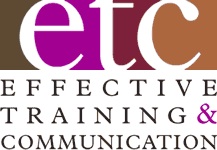And the beat goes on … readers continue indicating interest in this concise Q & A format for sharing simple Presentations Best Practices. This month, readers asked about stage fright, handouts vs. slides and eye contact.
1. How do I overcome Stage Fright?
Short answer – ‘You can’t – it’s a perfectly normal human response to fear or stress.’ But, here’s how I help my executive coaching clients manage their stage fright or Presentation Anxiety (PA). We focus on Minimizing and Masking Techniques.
Minimizing – your level of PA is based on a combination of causal factors, usually the fear of specific things like the fear of forgetting, fear of looking stupid, fear of not knowing your material, etc.
Start by precisely and completely identifying all those potential specific causes of your PA. Then, for each, indicate specific actions you can easily take to minimize that cause factor. If it’s fear of forgetting, the minimizing actions could be to have easy to use speaker notes and practice a lot more. Your comprehensive list of action steps become your PA Minimizing Plan.
Masking – but there will always be a level of PA remaining no matter what you do and that level can vary by the kind of presentation, audience make up and other factors. So, mask what’s left by not saying or doing anything to project fear, stress or lack of confidence and consciously displaying certain behaviors that do project confidence. ≈ One effective example is to smile more. Another is to slow down. Even if all this is an illusion, the audience’s perception is your reality. If you look and sound confident to them … you are!
So, while you can’t overcome Stage Fright, you can manage it by minimizing the impact of your specific causes and masking what’s left.
2. Can I use hard copies of slide decks as handouts?
Short answer – bad idea.
- Effective speaker support slides have specific design requirements to add value to the audience and the message Effective handouts have different design requirements for audience note-taking, sharing with those who didn’t attend or downstream content review. The problem is that when presenters try to use one tool for two different purposes, they fail at both.
- Effective slides should be simple, clear and relevant with more pictures than bullets and a minimal amount of text. Handouts for audience note-taking should have topic headings and white space for notes. Those used to share with others or for downstream review can be simple expanded full sentence outlines or bulleted paragraph documents.
- You’ve probably seen handouts with two columns of three or four reduced slides – where you can’t read the slides or make out the charts – and adjacent lines for notes That feature was designed for creating speaker notes, NOT audience handouts. Speakers didn’t need to be able to read the reduced slides because they already knew what was on them. The space for notes was for their talking points that went along with each slide.
- So why do we see so many speakers using that feature for handouts or otherwise creating ineffective ones? Because they can! They’re very busy or lazy or don’t care enough to create excellent slides that are different from excellent handouts. And the audience can usually tell.
Invest the extra time and effort to create appropriate – and different – audience-centric tools. You’ll earn an excellent ROI with your audience.
3. What if I look at an audience member who isn’t looking back at me?
First, don’t try to figure out why the person isn’t looking back at you. He or she might be looking down at the handout, taking notes, thinking, texting a message or daydreaming. Just because they’re not looking at you doesn’t mean they’re not interested, engaged or enjoying the presentation.
Second, avoid immediately jumping to someone else who is looking back at you. This can cause you to start scanning and your eye movements can become jerky and awkward. Simply look at that person’s head for 8 – 10 seconds, then move on in silence to someone else. Other people will see you looking in that person’s direction and may not notice or care that he or she wasn’t looking back. If you can’t make eye contact, at least you can make ‘head contact’.
So, keep those cards and letters coming in folks … maybe next month we’ll answer your question.

